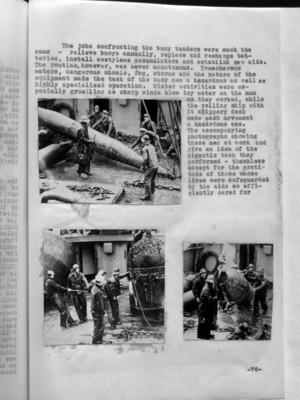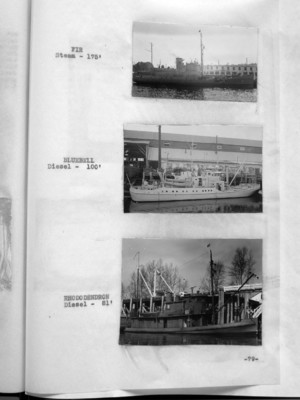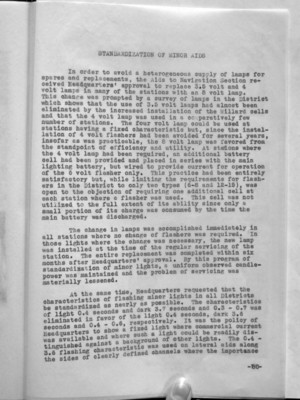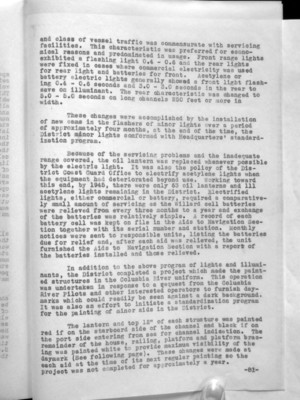Pages
96
The jobs confronting the buoy tenders were much the same - relieve buoys annually, replace and recharge batteries, install acetylane accumulators and establish new aids. The routine, however, was never monotonous. Treacherous waters, dangerous shoals, fog, storms and the nature of the equipment made the task of the buoy men a hazardous as well as highly specialized operation. Winter activities were especially gruelling as sharp winds blew icy water on the men as they worked, while the rolling ship with it slippery deck made each movement a hazardous one. The accompanying photographs showing these men at work and give an idea of the gigantic task they performed - thankless except for the gratitude of those whose lives were safeguarded by the aids so efficiently cared for.
97
At the outbreak of the war, the MANZANITA was fitted out and supplied with special submarine cables for the laying of a protective loop across the approach to Dutch Harbor and again, she was loaned to the Canadian authorities for the laying of a similar cable at Prince Rupert. The tenders performed their regular duties during the war, but were equipped with small arms, depth charge racks and deck guns for protection against enemy submarines. This armament was removed following cessation of hostilities and the complements of the tenders thereby gradually reduced.
99
STANDARDIZATION OF MINOR AIDS
In order to avoid a heterogeneous supply of lamps for spares and replacements, the Aids to Navigation Section received Headquarters' approval to replace 3.5 volt and 4 volt lamps in many of the stations with an 8 volt lamp. This change was prompted by a survey of lamps in the District which shows that the use of 3.5 volt lamps had almost been eliminated by the increased installation of the Willard cells and that the 4 volt lamp was used in a comparatively few number of stations. The four volt lamp could be used at stations having a fixed characteristic but, since the installation of 4 volt flashers had been avoided for several years, insofar as was practicable, the 8 volt lamp was favored from the standpoint of efficiency and utility. At stations where the 4 volt lamp had been required, an additional battery cell had been provided and placed in series with the main lighting batter,y but wired to provide current for operation of the 6 volt flasher only. This practice had been entirely satisfactory but, while limiting the requirements for flashers in the District to only two types ( 6-8 and 12-15), was open to the objection of requiring one additional cell at each station where a flasher was used. This cell was not utilized to the full extent of its ability since only a small portion of its charge was consumed by the time the main battery was discharged.
The charge in lamps was accomplished immediately in all stations where no charge of flashers was required. In those lights where the charge was necessary, the new lamp installed at the time of the regular servicing of the station. The entire replacement was completed withing six months after Headquarters' approval. by this program of standardization of minor lights, a uniform observed candle-power was maintained and the problem of servicing was materially lessened.
At the same time, Headquarters requested that the characteristics of flashing minor lights in all Districts be standardized as nearly as possible. The characteristics of light 0.4 seconds and dark 3.7 seconds and 0.4 - 0.6, respectively. It was the policy of Headquarters to show a fixed light where commercial current was available and where such a light could be readily distinguished against a background of other lights. The 0.4- 3.6 flashing characteristic was used on lateral aids along the sides of clearly defined channels where the importance
-80-
100
and class of vessel traffic was commensurate with servicing facilities. This characteristic was preferred for economical reasons and predominated in usage. Front range lights exhibited a flashing light o.4-0.6 and the rear lights were fixed in cases where commercial electricity was used for rear light and batteries for front. Acetylene or battery electric lights generally showed a front light flashing 0.4-0.6 seconds and 3.0 - 3.0 seconds in the rear to save on illuminant. The rear characteristic was changed to 5.0-5.0 seconds on long channels 250 or more in width.
These changes were accomplished by the installation of new cams in the flashers or minor lights over a period of approximately four months, at the end of the time, the District minor lights conformed with Headquarters' standardization program.
Because of the servicing problems and the inadequate range covered, the oil lantern was replaced whenever possible by the electric light. It was also the policy of the District Coast Guard Office to electrify acetylene lights when the equipment had deteriorated beyond use. Working toward this end, by 1945, there were only 63 oil lanterns and 111 acetylene lights remaining in the District. Electrified lights, either commercial or battery, required a comparatively small amount of servicing as the Willard cell batteries were relieved from every three months to a year and exchange of the batteries was relatively simple. A record of each battery cell was kept on file in the Aids to Navigation Section together with its serial number and station. Monthly notices were sent to responsible units, listing the batteries due for relief and, after each aid was relieved, the unit furnished the Aids to Navigation Section with a report of the batteries installed and those relieved.
In addition to the above program of lights and illuminants, the District completed a project which made the painted structures in the Columbia River uniform. This operation was undertaken in response to a request from the Columbia River Pilots and other interested operators to furnish daymarks which could readily be seen against a dark background. It was also an effort to initiate a standardization program for the painting of minor aids in the District.
The lantern and top 12th of each structure was painted red if on the starboard side of the channel and black if on the port side entering from sea for channel indication. The remainder of the house, railing, platform and platform bracing was painted white to provide maximum visibility of the daymark ( See following page). These changes were made at each aid at the time of its next regular painting so the project was not completed for approximately a year.




